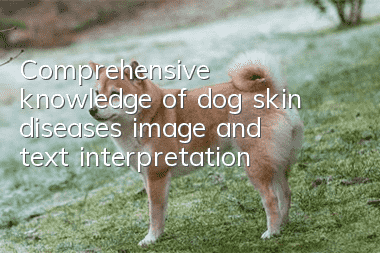Comprehensive knowledge of dog skin diseases (image and text interpretation)

If your dog keeps scratching on its body and making sharp barks, or if there are red rashes, dandruff, hair loss, etc. somewhere on its body. Then your pet may be suffering from a skin disease. Below we provide some pictures of common pet dog skin diseases for your reference. At the same time, we remind you that if you cannot deal with your pet dog’s skin diseases, we recommend that you go to a local pet hospital for treatment
1. Allergic skin disease
Some pet dogs will have allergic reactions to bath products and food. At the same time, the surrounding environment can also stimulate the occurrence of allergic skin diseases in dogs, such as pollen, mosquito bites, etc. Dogs suffering from atopic dermatitis will scratch constantly. If you scratch the area where the dog keeps scratching, you will find an ugly rash. Corticosteroids can be used for allergic skin diseases, but it is best to avoid contact with allergens.
2. Yeast infection
If your dog keeps scratching its ears and licking its paws, you can go to the hospital to check whether it is a yeast infection. Pet dogs with yeast infections will be angry, itchy, or have skin discoloration or loss for no reason. Yeast usually reproduces in places that are favorable to it, such as paws, ears, etc. Therefore, these two places are usually the most susceptible parts of dogs to infection. Yeast infections are easy to diagnose and can be treated with regular ointments, unless your veterinarian recommends oral medications or medicated baths.
3. Folliculitis
Superficial folliculitis is an infection that causes lumps, scabs, and sores on your dog’s skin. Short-haired dogs are more susceptible to this type of folliculitis, while long-haired dogs may suffer from loose skin tags and peeling. Dogs suffering from folliculitis generally suffer from scabies, allergies, abrasions and other skin diseases. The general treatment method is to use oral antibiotics, antibacterial plasters and dog shampoo.
4. Pyoderma
Pyoderma is another common bacterial infection. Pyoderma is common in puppies. Dogs with pyoderma will develop pustules. After a long time, they will burst and then form scabs. Generally, pustules will appear in areas with little hair or hair loss. abdomen. This disease can be treated with topical medications. A small number of dogs will continue to spread when they suffer from pyoderma, which is difficult to cure after long-term treatment.
5. Seborrheic dermatitis
Seborrheic dermatitis will cause the dog's skin and hair to become very greasy and accompanied by dandruff shedding. This disease has a certain hereditary nature. Some dogs will develop seborrheic dermatitis until they reach a certain age. . Dogs with seborrheic dermatitis often suffer from other complications, such as allergies and hormonal abnormalities. In the case of pets with multiple diseases, it is most important to treat seborrheic dermatitis first.
6. Ringworm
Ringworm is a disease that originates from dogs’ heads, paws, and ears.Canine skin diseases caused by fungi on the fore and upper limbs, etc. Dogs with ringworm will have inflamed, scaly small circles locally, and can also cause alopecia in dogs. Dogs under one year old are most likely to suffer from this disease. The disease is easy to spread, especially in kennels and homes. Various antibiotic treatments are best for this disease.
7. Alopecia
Anyone who owns a dog knows that dogs shed to some extent, but the amount of hair shedding has a certain relationship with the breed, season and environment. Dogs that often go out for a walk or are sick or malnourished will lose hair. There is a lot of hair. If the dog loses hair for more than a week or if localized hair loss is found, he should go to the pet hospital for treatment.
8. Scabies
Scabies is a skin disease caused by mites. Scabies is also known as scabies. In addition to being spread among dogs, the disease can also be transmitted to humans, but it does not parasitize humans. People with scabies Dogs will have symptoms of severe itching, red skin, ulcers, and hair loss. Scabies is most likely to occur on dogs’ ears, face, and legs. Vermintic mange, on the other hand, only occurs in dogs and can cause alopecia areata, scabs and ulcers. Treatment depends on the type of scabies.
9. Fleas
If the dog owner is not careful enough, he will not find fleas on the dog. Dogs with fleas on their bodies will have symptoms such as excessive licking, scratching, scabs, and alopecia areata. If there is a severe flea infestation, it will cause anemia in the dog. Secondly, it can also cause other diseases (such as internal parasites). To remove fleas in dogs, you can use repellent spray.
10. Tick
Like fleas, ticks feed themselves by sucking blood. If you check carefully, you will find that the tick is adsorbed on the dog's skin. At this time, you can use tweezers to gently pull the tick out straight, but be careful. Do not apply too much force, otherwise the tick's head may break off on the dog's skin, causing skin infection. Kill the removed ticks with something and then throw them into the toilet to prevent dogs from eating them.
11. Changes in skin color or texture
If your dog’s skin changes or has abnormal changes, this may be caused by metabolism or hormones, so we strongly recommend that you go to a pet hospital for treatment.
12. Dry and peeling skin
Dry and flaky skin in dogs may be a sign of skin diseases. Skin diseases such as allergies and scabies can also cause dry and flaky skin in dogs. But in most cases, dryness and peeling are not serious problems. Just like human skin, it may become dry in winter. If your dog is feeling unwell, you can go to the pet hospital
13. Licking dermatitis
Lick dermatitis is caused by the onset of other skin diseases that prompt dogs to lick one place non-stop. The most common is the front of the calf. The dog's non-stop licking causes the area to fail to heal. The reason why this is possible It's caused by pain and itching. To treat this skin disease, you should first find the underlying cause.
14. Skin tumors
Skin tumors can be fatal to dogs. If you find small tumors on your dog's skin, you should consult your veterinarian as soon as possible.
15. Acute wet dermatitis
Acute wet dermatitis refers to small areas of red, inflamed skin on your dog. Commonly found on dogs’ heads, buttocks, and chest. (It is recommended that you do not touch it) Causes of acute wet dermatitis in dogs include infection, allergies, mosquito bites, and licking.
16. Immune dysfunction
Some dogs will have such a situation, the skin will not heal after infection or damage. This allows us to diagnose dogs with immune disorders, the most famous of which is lupus erythematosus, which affects not only dogs but also people. Lupus can cause skin and liver problems in dogs.
Recommended Good Things
Aineng Pet Odor Eliminating Disinfectant can effectively remove body odor/feces odor and other odor molecules! Effectively treats skin diseases caused byfungi/bacteria! Can killparvovirus/canine distemper virus/coronavirusetc.!
It is edible grade for pets, does not contain fragrances, does not contain chemicals, can be sprayed directly, and is harmless to human pets!
Consultation:13028809308 (WeChat synchronization)
Scan the QR code on WeChat to enter the purchase
- How long does it take for dogs to be dewormed before all the worms are killed?
- Signs of depression in dogs, come and see if your dog has it
- What should you do when faced with "fungi + mites + inflammation"?
- Select competition-grade Husky puppies based on bone proportions
- Illustration of the correct ways and precautions to greet your dog
- Dogs have dandruff and hair loss
- What to do if Teddy can’t digest dog food
- Will the ancient shepherd dog recognize its owner?
- Does Corgi recognize its owner?
- Can a dog recover after being hit by a car and unable to stand on its hind legs?



